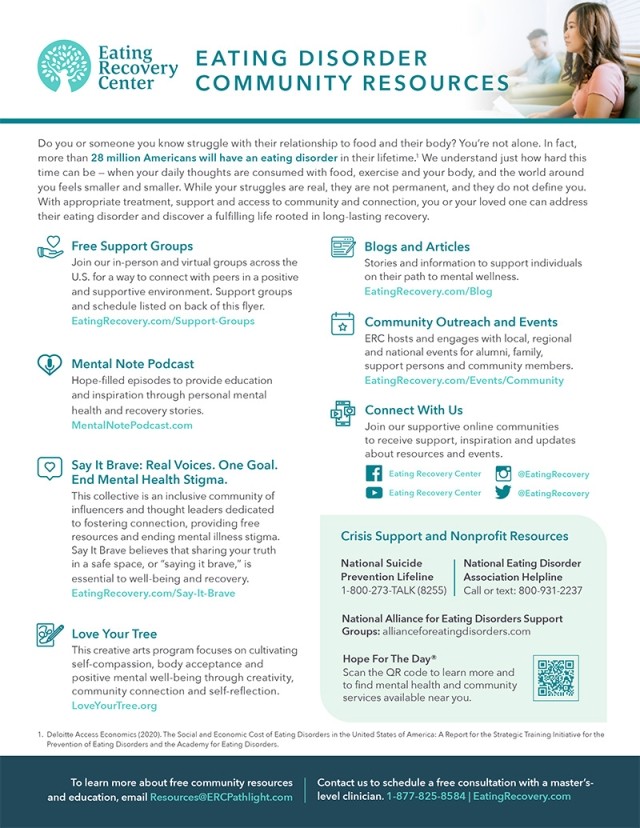
What is an eating disorder?
Eating disorders are serious illnesses affecting people of all ages, races, ethnicities, genders, shapes and sizes. People with eating disorders experience a lot of distress related to their food intake, body image or weight.

Real People. Real Stories. Real Progress.
Our expert care teams ensure people of all ages, races and gender identities get the exact support they need at each stage of their recovery. With the right care, lasting healing is possible – and we have the data to show it.
73% of patients no longer reported significant eating disorder symptoms
Types of eating disorders
Nearly one in ten people in the U.S. will have an eating disorder in their lifetime.[1] The more commonly known eating disorders include:
Additional eating disorders/types of disordered eating include:
- Avoidant/resistant food intake disorder (ARFID)
- Atypical anorexia
- Diabulimia
- Other specified feeding and eating disorders (OSFED)
- Orthorexia
Eating disorders can be fatal. Tragically, one person in the U.S. dies every 52 minutes from complications related to an eating disorder.[1]
Sources
1. Deloitte Access Economics. The Social and Economic Cost of Eating Disorders in the United States of America: A Report for the Strategic Training Initiative for the Prevention of Eating Disorders and the Academy for Eating Disorders. June 2020.
What causes eating disorders?
There is no single cause of eating disorders. Eating disorders can have multiple causes, including:
- Genetic causes
- Social and cultural causes
- Environmental causes
- Psychological causes
Some research has tied vegan and vegetarian diets to eating disorders. Other research shows that more time on social media is directly connected to a noticeable increase in disordered eating.
Co-occurring conditions
Certain eating disorders, like ARFID, may be more common in people with obsessive-compulsive disorder (OCD) and attention-deficit hyperactivity disorder (ADHD). People with ADHD may also be more likely to experience binge eating habits. People with diabetes may also be at increased risk for eating disorders.
No one is immune to eating disorders. Eating disorders affect people of every age, sex, gender, race, ethnicity, and socioeconomic group.

Genetic causes of eating disorders
If someone in your family has been diagnosed with an eating disorder, you may be more likely to develop symptoms of an eating disorder. However, parents should know that you are not to blame for your child’s eating disorder.
Certain genes may increase a person’s risk for developing an eating disorder. We often see eating disorder symptoms pop up across multiple generations within the same family.
Social and cultural causes of eating disorders
Media images
Every day, we are besieged with altered images on TV, in the movies, in magazines and on our mobile devices showcasing artificial and unrealistic beauty standards. Society and the media continue to push “thin” body types with low body fat as the norm or “ideal.”
Social media
Young teenage brains lack the developmental and coping skills necessary to process these altered images in a healthy, neutral way. Perfectionistic and high-achieving individuals may be more at risk to succumbing to cultural messages claiming that “thin is best.”
Environmental causes of eating disorders
Research studies have shown that one's environment makes up about 20-50% of the “cause effect” of an eating disorder.
Environmental risk factors that may lead to eating disorders include:
- Having a trauma history
- Being a competitive athlete
- Being pressured to look or act a certain way
- Having high expectations for grades
- Life transitions and developmental changes
- Other challenging family dynamics
Interestingly, how a child is parented or brought up has less of an effect than how that child internalized his or her life experiences.
How each person processes their own experiences has a powerful effect in determining their risk for developing an eating disorder.
Psychological causes of eating disorders
We are all born with certain traits and tendencies. Having a certain temperament or having pre-existing mental health concerns can increase a person’s risk of developing an eating disorder.
Stressful life events like going to college, moving to a new town, or a major family change (divorce, death) may also increase the risk.
Additionally, these traits and co-occurring conditions are more commonly associated with people with eating disorders:
Do diets cause eating disorders?
Going on a diet can be a risk factor for developing an eating disorder, particularly if an individual’s brain is affected by long periods of fasting or malnutrition. A starving brain works differently than a brain that is properly fed. Brain changes that follow severe dieting can include:
- Cognitive changes (thinking differently)
- Psychological changes (processing information differently)
- Emotional changes (feeling differently)
Thankfully, the brain can recover from eating disorders. But the longer the eating disorder continues, the more serious the brain changes can be. This is why eating disorder treatment with an experienced professional is so critical and should be started as soon as an eating disorder is suspected.

Eating disorder symptoms
Since each individual experiences an eating disorder differently, eating disorder symptoms vary from person to person. Symptoms also vary depending on the type of eating disorder. Some eating disorder symptoms are noticeable, like lanugo hair growth or scalp hair loss with anorexia, and cheek swelling or tooth damage from bulimia. Eating disorders are inherently secretive mental illnesses. This can make the detection of symptoms quite difficult.

Physical symptoms of eating disorders
You cannot always tell if someone has an eating disorder just by looking at them. However, there are some physical symptoms of eating disorders that you can watch for, including:
- Compulsive or excessive exercise
- Dramatic or rapid weight loss
- Loss of menses
- Frequent stomach cramps or stomach pain
- Food wrappers in odd places or food disappearing from the house (related to binge eating)
- Visiting the bathroom immediately after each meal (related to purging)
- Calluses on the back of the hands and knuckles, known as Russell's sign (caused by purging/self-induced vomiting)
Emotional symptoms of eating disorders
Eating disorders typically involve extreme emotions and attitudes about food and weight. People with eating disorders tend to suffer from distressing mental health symptoms including anxiety, depression, suicidal ideation and substance abuse. The following emotional warning signs can indicate the presence of an eating disorder:
- Plummeting grades or refusing to go to school
- Behavior changes (acting differently)
- Isolation and withdrawing from others
- Being less interested in daily activities
- An increase in mood swings, irritability or high anxiety
- Low self-esteem
- Emotional numbness or lack of emotion
Symptoms of different eating disorders
Anorexia, bulimia and binge eating disorder are some of the most common, well-known eating disorders. These eating disorders are also extremely challenging and can impact one's mental and physical health in drastic ways. We review symptoms of these eating disorders below.
Symptoms of anorexia nervosa
Anorexia nervosa is a potentially life-threatening illness characterized by the following eating disorder symptoms and signs:
- An abnormally low body weight
- An intense fear of gaining weight
- A distorted perception of weight or shape
People with anorexia use extreme measures to control their weight, such as:
- Over-exercising
- Laxative or diet aid abuse
- Excessively restricting calories
These patients will present abnormal medical and lab test results that show signs and symptoms of malnourishment, leading to dry skin, hair loss, lanugo and more.
Individuals with anorexia come in all shapes and sizes. People with anorexia in larger bodies may be diagnosed with atypical anorexia.
Symptoms of bulimia nervosa
Bulimia nervosa is a serious, potentially life-threatening eating disorder characterized by bingeing on large portions of food and then purging, excessively exercising, or using diet pills or laxatives. People with bulimia don’t always show outward physical signs of an eating disorder; they may have a smaller build or live in a larger body.
Many people with bulimia restrict their eating, which can lead to more binge eating and purging, Someone in the grips of bulimia may head to the bathroom immediately after a meal. This could be a red flag. Other bulimia symptoms that often stem from self-induced vomiting include:
- Cheek and face swelling (sometimes called "chipmunk cheeks")
- Mouth/tooth damage
- Calluses on the knuckles (Russell's sign; sometimes called "bulimia knuckles")
Symptoms of binge eating disorder
People with binge eating disorder (BED) regularly eat too much food (binge) and feel a lack of control over their eating. Typically, they eat quickly or eat more food than intended, even when not hungry, or they may continue eating even long after they’re uncomfortably full.
People who binge eat frequently may feel guilty, disgusted or ashamed by their behavior and the amount of food eaten. Many times, they overeat in private or struggle with binge eating at night. New bouts of bingeing usually occur at least once a week. Sufferers can be normal weight, overweight or obese.
Related reading
Side effects of eating disorders
Eating disorders are serious illnesses accompanied by life-threatening physical and mental health complications. The side effects of eating disorders can damage nearly every organ and system in the body, leading to an increased mortality rate. Thankfully, many eating disorder complications are reversible, but it is vital to seek treatment as soon as possible.

Long-term effects of eating disorders
For children, adolescents and young adults, the long-term effects of eating disorders can be very serious or even fatal, and include:
- Malnutrition or developmental delays
- Serious organ damage
- Joint issues or muscle weakness
- Constipation or irregular bowel movements
- Dizziness
- Fatigue
- Dehydration
- Infertility
- Death
Tragically, a person dies every 52 minutes from an eating disorder in the U.S. [1]
Sources
1. Deloitte Access Economics. The Social and Economic Cost of Eating Disorders in the United States of America: A Report for the Strategic Training Initiative for the Prevention of Eating Disorders and the Academy for Eating Disorders. June 2020.
Mental health and eating disorders
An eating disorder may start out as an attempt to lose weight. As the eating disorder behaviors continue, people with eating disorders may notice their mental health symptoms worsening. Mental health concerns affecting people with eating disorders include:
- Anxiety
- Depression
- Obsessive compulsive disorder (OCD)
- Post-traumatic stress disorder (PTSD)
- Self-harm behaviors (cutting)
- Suicidal ideation
- Substance abuse
- Perfectionism
Consequences of eating disorders
Eating disorders can cause both long- and short-term consequences, depending on the type of eating disorder, how frequent the eating disorder behaviors occur, and the length of time that a person has been living with the eating disorder.
Consequences of anorexia
People with anorexia often turn to extreme measures to lose weight. These weight loss behaviors can cause significant health problems, including:
- Hair thinning or hair loss
- Fine hair growth on the body (lanugo)
- Gastrointestinal issues (nausea, stomach pain, bloating)
- Bradycardia
- Bone health issues including osteopenia, fractures and osteoporosis
- Anemia
- Cold intolerance
- Extreme exhaustion
Additionally, people with anorexia are at an increased risk of dying due to the risks of these serious medical complications and from high rates of suicidality.
Consequences of bulimia
Bulimia symptoms of bingeing (eating a large quantity of food in a short time, followed by feelings of distress) and purging (self-induced vomiting, abusing laxatives, etc.) can lead to a host of medical complications, including:
- Dental issues
- Cheek and face swelling (sometimes called "chipmunk cheeks")
- Gastroesophageal reflux (GERD)
- Esophageal irritation, erosions, ulcers, bleeding and rupture
- Pain with swallowing or trouble swallowing
- Coughing or frequent sore throats
- Cardiac issues
- Fertility problems
Consequences of binge eating disorder
Binge eating disorder, which involves frequent episodes of overeating marked by distress and lack of control, is associated with a number of serious medical complications, including:
- Weight gain
- High blood pressure
- High cholesterol
- Heart disease
- Type II diabetes mellitus
- Feelings of embarrassment, guilt or shame
- Worsening anxiety and depression
Treatment for eating disorders
In eating disorder treatment, we address all existing physical and mental health concerns using supportive, evidence-based therapeutic interventions that treat the whole person — body, mind and spirit.

What to expect in eating disorder treatment
Eating disorders are complex illnesses. Working with a multidisciplinary team offers the best outcomes for eating disorder recovery. When you enter an eating disorder treatment center, you may work with multiple experts, including:
- Psychiatrists and physicians
- Family therapists, individual therapists and group therapists
- Dietitians
- Nurses
- Music or art therapists
- Alumni coordinators
- Support staff, and more
The team works collaboratively to create individualized treatment plans for each patient, offering support and a safe place to practice new skills learned in treatment.
Nutritional counseling for eating disorders
A nutrition program is an essential component of eating disorder treatment. Individuals that have been restricting foods, bingeing or purging are prescribed a personalized nutritional program based on their symptoms, their health status and how long the eating disorder has been present. The goal is to help each individual:
- Develop a healthy relationship with food
- Eat a variety of foods in a balanced way
- Enjoy food in moderation
Nutritional groups, assessments and meal plans are an important part of each day in treatment. Here at Eating Recovery Center, patients collaborate with our experienced registered dietitians throughout the nutritional rehabilitation process.
Eating disorders therapy
Therapy is another very important part of eating disorder treatment. Licensed and experienced clinicians provide a number of evidence-based therapies shown to be effective and beneficial, based on clinical research studies and observations. Therapeutic work is centered around challenging and addressing unhealthy thought patterns and behaviors and learning new skills to replace them. Therapies that may be used in treatment include:
- Acceptance and Commitment Therapy (ACT)
- Dialectical Behavior Therapy (DBT)
- Cognitive Behavioral Therapy (CBT)
- Exposure Therapy
In treatment, patients may work with an individual therapist, a family therapist and group therapists. Trauma, anxiety, stress, depression, suicidality, body image concerns (body dysmorphia) and other types of distress can all be addressed.
Medication for eating disorders
In eating disorder treatment, medications may be prescribed to address physical health concerns and complications related to the eating disorder. Medications may also be prescribed to address mental health symptoms and internal distress, including symptoms of anxiety, depression or suicidality. In treatment, psychiatrists and other medical professionals meet with patients regularly to monitor medication effectiveness and potential side effects. Nursing support is also provided in many eating disorder treatment centers.
Eating disorder medical abbreviations
We are often asked about common eating disorder abbreviations, terms and acronyms. People want to know:
- What do PHP and IOP mean?
- What is B/P in eating disorder care?
- What are the different types of mental health professionals?
We answer these questions more here in our helpful resource: 100+ Common Eating Disorder Abbreviations, Acronyms and Terms.
Get matched with the exact support you need.
With one conversation, our mental health professionals will help you better understand what you’re going through and what you need.
We will meet you where you are, listen to your story in a therapeutic setting, and match you with the level of support that meets your struggle.

Find help for the different types of eating disorders
When an individual is struggling with an eating disorder, treatment can be life-saving. At Eating Recovery Center, we offer multiple treatment options for all types of eating disorders, including:
- Virtual intensive outpatient programming (Eating Recovery At Home)
- Intensive outpatient programming (IOP) - on-site
- Partial hospitalization programming (PHP)
- Residential
- Inpatient
- Intensive care unit
Statistics on eating disorders
Eating disorders are serious, chronic illnesses that greatly impact a person’s mental and physical health and quality of life. At times fatal, eating disorders are complex and can be challenging to overcome. Here are the latest eating disorder facts and statistics.
- Between 2018-2019, nearly 2 out of 100 people in the U.S. (5.48 million people) were living with eating disorders. [1]
- Females were more likely to be affected by eating disorders, at 2.62% (4.39 million people). [1]
- Approximately 1.09 million males had eating disorders (0.67%). [1]
- Looking at lifetime prevalence, nearly 1 in 10 females (8.60%) and 1 in 20 males (4.07%) will have an eating disorder during their lifetime. [1]
- The percentage of people living with eating disorders in the U.S. is expected to rise. [1]
- Eating disorders most commonly affect young women aged 20-24 and women aged 25-29. [1]
- The most common eating disorder as of 2019 was Other Specified Feeding and Eating Disorder (OSFED). [1]

Facts about eating disorders
Eating disorders are very dangerous and can be deadly.
- One person dies every 52 minutes from an eating disorder. [1]
- Eating disorders have the highest case fatality rates of any mental illness. [2]
- Eating disorder mortality rates are shown to be nearly six times higher for individuals with anorexia nervosa and nearly twice as high for those with bulimia nervosa, compared to the general population. [1]
- One in five people with anorexia nervosa die by suicide. [3]
- People with eating disorders are 20.1% less likely to be employed than others, leading to lost wages and other setbacks. [4, 5]
- Black, Indigenous, (and) people of color are half as likely to have their eating disorder be diagnosed or receive treatment. [1]
Risk factors for eating disorders
Risk factors for eating disorders include biological, psychological, and sociocultural factors, including:
- Genetics [6, 7, 8, 9]
- Gender (particularly for anorexia and bulimia) [10]
- Ethnicity
- Early childhood eating and gastrointestinal problems
- Negative self-evaluation
- Participation in sports focusing on weight (aesthetics or requirements) [11]
- Sexual abuse and other adverse life events [12, 13]
Additionally, anxiety disorders (particularly social anxiety) have been shown to commonly precede eating disorders. [14, 15] In one study of nearly 300,000 college students, those identifying as LGBTQ+ reported higher rates of self-reported eating disorders and compensatory behaviors. [16]
- View our LGBTQ+ eating disorder resource guide here.
- See how we are helping transgender individuals with eating disorders here.
Eating Disorder Books
Sick Enough by Dr. Jennifer Gaudiani
Find Online | Find at a Library
Eating Disorders: A Guide to Medical Care by Dr. Philip Mehler and Dr. Arnold Andersen
Find Online | Find at a Library
Healthy Bodies: Teaching Kids What They Need to Know by Kathy Kater LICSW
Find Online | Find at a Library
When Your Teen has an Eating Disorder by Lauren Muhlheim, PsyD
Find Online | Find at a Library
By Their Side: A Resource for Caretakers and Loved Ones Facing an Eating Disorder by Lara Lyn Bell
Find Online | Find at a Library
Loving Someone with an Eating Disorder by Dana Harron PsyD
Find Online | Find at a Library
Skills-based Caring for a Loved One with an Eating Disorder by Janet Treasure, PhD, Gráinne Smith, and Anna Crane
Find Online | Find at a Library
Help Your Teenager Beat an Eating Disorder, Second Edition By James Lock, MD, PhD and Daniel LeGrange, PhD
Find Online | Find at a Library
Ed Says U Said: Eating Disorder Translator by June Alexander and Cate Sangster
Find Online | Find at a Library
The Whole Brain Child by Daniel J. Siegel and Tina Payne Bryson
Find Online | Find at a Library
What Say to Kids When Nothing Seems Work by Adele Lafrance
Find Online | Find at a Library
Articles
- Our List of 50+ Eating Disorder Recovery Tips for Anorexia, Bulimia, Binge Eating and More
- Eating Disorder Relapse is Common: Here's What to Do About It
- Eating Disorders in College Students: 12 Ways to Focus On Recovery
- 15 Ways to Manage Eating Disorder Triggers
- Ozempic & Eating Disorders: Risks of Weight Loss Drugs
- The Link Between ADHD and Eating Disorders
- Eating Disorder Facts & Myths
- OCD & Eating Disorders: The Link Explained
- Eating Disorder Facts vs. Myths
- Exercising After Eating Disorder Treatment
- The History of Eating Disorders
- Eating Disorder Statistics
Websites
- Academy of Eating Disorders (AED)
- National Association of Anorexia Nervosa and Associated Disorders (ANAD)
- The Body Positive
- Eating Disorders Anonymous
- Eating Disorder Coalition for Research, Policy and Action
- The Eating Disorder Foundation, Denver, Colorado
- Eating Disorder Hope
- Eating Disorder Referral (EDReferral)
- Help Guide
- International Association of Eating Disorders Professionals (IAEDP)
- Multi-Service Eating Disorders Association, Inc. (MEDA)
- National Alliance on Mental Health Illness (NAMI)
- The National Eating Disorders Screening Program
- Feed Your Instinct
Facebook Pages
Eating Disorder FAQs
What causes eating disorders?
Eating disorders are caused by a combination of genetic, environmental, sociocultural and psychological factors. There is no one single cause of a person’s eating disorder. Eating disorders can affect people from all backgrounds; all ages, sexes, genders, races, ethnicities and socioeconomic groups are at risk for these serious conditions.
What are warning signs of eating disorders?
Warning signs of eating disorders include:
- An obsession with food, calories or dieting
- A preoccupation with one’s body size, shape or weight
- Skipping meals or avoiding eating in social situations
- Excessive exercise
- Binge eating (empty food wrappers)
- Purging (vomiting, laxatives)
- Other mental health symptoms, including anxiety, depression and social withdrawal
What are the health risks of eating disorders?
The health risks of eating disorders are numerous and include:
- Malnutrition or developmental delays
- Organ damage
- Joint issues or muscle weakness
- Constipation or irregular bowel movements
- Dizziness
- Fatigue
- Dehydration
- Infertility
- Anxiety
- Depression
- Substance abuse
- Perfectionism
- Obsessive compulsive disorder (OCD)
- Suicidal ideation
- Self-harm behaviors (cutting)
- Death
What resources are available to someone with an eating disorder?
Eating Recovery Center provides free, weekly eating disorder support groups. These groups offer participants numerous resources, along with peer connection, support and education. To learn more about these support groups and to learn more about how to get help for an eating disorder, please call us at 1-877-825-8584.
Are eating disorders life threatening?
Eating disorders are extremely dangerous and can be life-threatening. Consider these facts:
- A person dies every 52 minutes from an eating disorder in the U.S. [1]
- Eating disorders have the highest case fatality rates of any mental illness. [2]
- One in five people with anorexia nervosa die by suicide. [3]
Sources:
[1] Deloitte Access Economics. The Social and Economic Cost of Eating Disorders in the United States of America: A Report for the Strategic Training Initiative for the Prevention of Eating Disorders and the Academy for Eating Disorders. June 2020.
[2] Smink, F. R., Van Hoeken, D., & Hoek, H. W. (2012). Epidemiology of eating disorders: incidence, prevalence and mortality rates. Current psychiatry reports, 14(4), 406-414.
[3] Arcelus J, et al. Mortality rates in patients with anorexia nervosa and other eating disorders. A meta- analysis of 36 studies. Arch Gen Psychiatry. 2011;68(7):724–31.
[4] Alegria et al. (2016), Collaborative Psychiatric Surveys (CPES), 2001-2003.
[5] Samnaliev, M., Noh, H. L., Sonneville, K. R., & Austin, S. B. (2014). The economic burden of eating disorders and related mental health comorbidities: An exploratory analysis using the US Medical Expenditures Panel Survey. Preventive medicine reports, 2, 32-34.
[6] Hübel, C., Leppä, V., Breen, G. and Bulik, C.M., (2018). Rigor and reproducibility in genetic research on eating disorders. International Journal of Eating Disorders, 51(7), pp.593-607
[7] Polderman, T.J., Benyamin, B., De Leeuw, C.A., Sullivan, P.F., Van Bochoven, A., Visscher, P.M. and Posthuma, D., (2015). Meta-analysis of the heritability of human traits based on fifty years of twin studies. Nature genetics, 47(7), p.702.
[8] Duncan, L., Yilmaz, Z., Gaspar, H., Walters, R., Goldstein, J., Anttila, V., Bulik-Sullivan, B., Ripke, S., Eating Disorders Working Group of the Psychiatric Genomics Consortium, Thornton, L. and Hinney, A., (2017). Significant locus and metabolic genetic correlations revealed in genome-wide association study of anorexia nervosa. American journal of psychiatry, 174(9), pp.850-858.
[9] Pettersson, E., Lichtenstein, P., Larsson, H., Song, J., Agrawal, A., Børglum, A.D., Bulik, C.M., Daly, M.J., Davis, L.K., Demontis, D. and Edenberg, H.J., (2019). Genetic influences on eight psychiatric disorders based on family data of 4 408 646 full and half-siblings, and genetic data of 333 748 cases and controls. Psychological medicine, 49(7), pp.1166-1173.
[10] Weissman, R. S. (2019). The Role of Sociocultural Factors in the Etiology of Eating Disorders. Psychiatr Clin North Am, 42(1), 121-144. doi: 10.1016/j.psc.2018.10.009
[11] Neyland H, et al, (2020). Parental deployment and distress, and adolescent disordered eating in prevention- seeking military dependents. International Journal of Eating Disorders, vol 53, no. 2, pp.201-209.
[12] Jacobi, C., Hayward, C., de Zwaan, M., Kraemer, H. C., & Agras, W. S. (2004). Coming to terms with risk factors for eating disorders: application of risk terminology and suggestions for a general taxonomy. Psychol Bull, 130(1), 19-65.
[13] Culbert, K. M., Racine, S. E., & Klump, K. L. (2015). Research Review: What we have learned about the causes of eating disorders - a synthesis of sociocultural, psychological, and biological research. J Child Psychol Psychiatry, 56(11), 1141-1164.
[14] Bulik, C.M., (2002). Anxiety, depression and eating disorders. Eating disorders and obesity: A comprehensive handbook, 2(1), pp.193-198.
[15] Swinbourne, J.M. and Touyz, S.W., (2007). The co‐morbidity of eating disorders and anxiety disorders: A review. European Eating Disorders Review: The Professional Journal of the Eating Disorders Association, 15(4), pp.253-274.
[16] Diemer EW, Grant JD, Munn-Chernoff MA, Patterson DA, Duncan AE. (2015). Gender Identity, Sexual Orientation, and Eating-related Pathology in a National Sample of College Students. J Adoles Health. 57(2);144-149.
[17] Eating Recovery Center (2019). Treatment Outcomes Report.
Hide Last Child Layout Div











